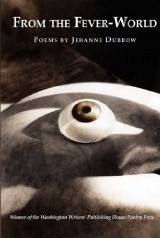From the Fever-World by Jehanne Dubrow From the Fever-World
|  |
Who is Ida Lewin, the narrator of the poems found in From the Fever-World by Jehanne Dubrow? According to the translator’s note found at the end of the book, "Ida Lewin (or someone like her) existed in the imaginary Polish town of Always Winter. “Maybe she was born in 1906." Dubrow goes on to explain that "She died in 1938, during a flu epidemic" and that in 1986, two schoolchildren found some of her written documents including "A sheaf of crumpled pages" that appear to be what is left of Ida’s poetry.
It’s this sheaf that makes up Dubrow’s second full-length collection of poetry. Acting as a translator, fictional or otherwise, Dubrow dives into the world of an early 20th century Yiddish poet, who is sometimes a mystical seer, sometimes a wife and homemaker, sometimes a mother, and always a woman.
The poems in this collection do not have specific titles (the acknowledgments page states that many of the individual poems were published under the first lines), so it is easy to follow Dubrow’s collection as a single story instead of a set of individual works. Ida is first introduced to the reader through the context of a physical place called Always Winter where "thistles remain needles, each blade / of grass a blade that slices / to our soles." But it’s not just the harsh outside landscape that envelopes this main character. We also see her domestic world in kitchens, in markets and in a woman’s duties: "In a woman’s life / all lists become her poetry / so that a recipe for cake / is just the verse form / of desire."
And a woman, Ida most certainly is. We never forget this, as we read her conflicts with her religion, her relationships, even her own body. For instance, we see as the narrator tries "the trick of making honey cake" in one poem and in another poem she describes how she sleeps in a separate bed from her husband, "I was bleeding / a white cloth turning red / between my thighs." Certainly, Ida’s world is one that has been pushed aside by history, and the narrator knows this. Outside of offering observations, many of her poems show the struggle of capturing the intimate glimpse into this forgotten world:
Consider the present
for my mother, a carp
wrapped in white paper
tied with twine –
It held
a poem too,
She never read
my fish scale sentences..
Aside from the outside conflict, there are also hints that nothing may be what it seems. In one poem, Ida explains a ceremony: "Before the wedding, a bride unveils / to prove that she’s the wife / her husband bargained for." Then, she goes on to offer her own commentary:
Truth is: the face remains obscured,
no matter how transparent the gauze
silk thin a whisper
in the wedding bed, white lace
composed of thread and emptiness.
Ida’s world is a conflicted one. It is also one of tragedy, for perhaps this poet is one who can see the future. Her poems ring with dark nightmares and shadows. In one poem we see "the ash bird / soaring through the squire— / animal that doesn’t fly / with June, but caws the wind, its prophecy the daggered beak / its gullet overflowing worms." In another, she dreams "the myth of men / who lead the living / to the dead." Knowing the date of Ida’s life, we have to ask ourselves: Are these dark images omens of personal tragedy or something more widespread? It’s not clear. What we do know that at the end of the collection, Ida is haunted by the death of her own child, saying, "I cannot hold her fingers / anymore, those tiny ropes / that used to choke my thumbs".
Through this collection, we get to see so much of Ida’s life that it would seem we know her personally. But of course, we don’t. Because this collection is a work of translation, pretend or otherwise, we have to allow for the missing pieces. Of course, not every word has survived. What has been lost? What has been gained by what has been lost? And what is the role of Dubrow who is the poet/translator? What does a poet in the 21st century hope to capture by splicing the pieces of a lost life in poetry fragments together?
There are, of course, no clear answers to these questions. And that is okay. Putting down this collection, the reader should be satisfied to live with the unanswered questions and relish this surreal and lyrical world that at times may seem incredibly sad, but mostly is both strangely eerie and magical.
Reviewed by Karen Weyant.
Poets’ Quarterly | October 2009.